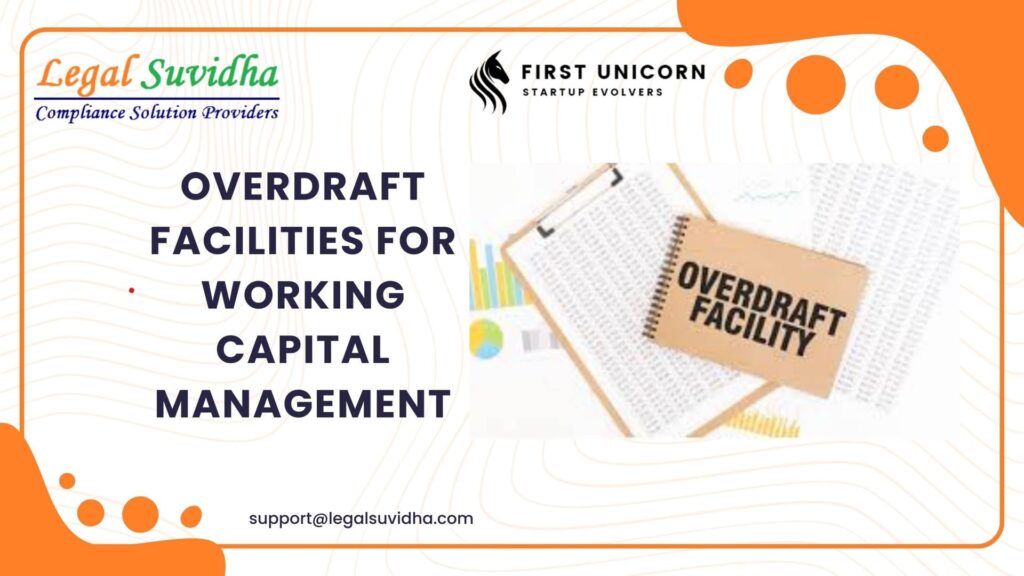Overdraft Facilities for Working Capital Management in India
1. Introduction to Overdraft Facilities
An overdraft facility allows businesses to withdraw more money than what is available in their bank account, up to a pre-approved limit. This financial tool is crucial for managing short-term liquidity needs and ensuring operational efficiency.
2. How Overdraft Facilities Work in India
- Pre-Approved Limit: Credit limit based on borrower’s creditworthiness, turnover, and collateral.
- Interest on Utilized Amount: Interest is charged only on the amount used.
- Flexible Repayment: No fixed repayment schedule.
- Renewable Annually: Typically reviewed and renewed annually.
3. Types of Overdraft Facilities in India
- Secured Overdrafts: Backed by collateral, offering lower interest rates.
- Unsecured Overdrafts: No collateral required; higher interest rates.
- Overdraft Against Fixed Deposits (ODFD): Linked to pledged fixed deposits.
- Overdraft Against Receivables: Utilizes future payments for cash flow.
4. Benefits of Overdraft Facilities for Working Capital Management
- Flexibility: Withdraw funds as needed without fixed EMIs.
- Cost-Effectiveness: Interest on utilized amount only.
- Business Continuity: Ensures uninterrupted operations.
- Seasonal Adaptability: Ideal for businesses with seasonal sales cycles.
5. Eligibility Criteria for Overdraft Facilities in India
- Business Vintage: 1-3 years of operational history.
- Financial Performance: Consistent cash flow and profitability.
- Turnover: Annual turnover and transaction volume.
- Credit Score: CIBIL score of 750+ preferred for unsecured options.
6. Documentation Required for Overdraft Facilities in India
- KYC documents (Aadhaar, PAN, etc.).
- GST returns and audited financial statements.
- Income tax returns for 2-3 years.
- Bank account statements (6 months to 1 year).
7. Overdraft vs. Other Working Capital Financing Options
| Feature | Overdraft | Working Capital Loan | Line of Credit |
|---|---|---|---|
| Repayment Schedule | Flexible | Fixed EMIs | Flexible |
| Interest Charged | On utilized amount | On full loan amount | On utilized amount |
| Collateral Requirement | Optional | Often required | Optional |
| Approval Time | Quick | Moderate | Quick |
8. Interest Rates and Charges on Overdraft Facilities in India
Typical Interest Rates:
- Secured Overdrafts: 8%-12% annually.
- Unsecured Overdrafts: 12%-18% annually.
Additional Fees: Processing fees (1%-2%), renewal fees (annually).
9. How to Apply for an Overdraft Facility in India
- Choose a lender based on competitive rates.
- Prepare necessary documents.
- Submit the application online or at the branch.
10. Key Risks and Challenges of Overdraft Facilities
- Over-utilization of funds.
- High interest for unsecured options.
- Risk of limit reduction or collateral loss.
11. Use Cases
Examples of how businesses leverage overdraft facilities:
- Bridging payment cycles.
- Seasonal purchases.
- Emergency expenses and payroll management.
12. Top Indian Banks and NBFCs Offering Overdraft Facilities
- State Bank of India (SBI), HDFC Bank, ICICI Bank, Axis Bank.
- NBFCs: Bajaj Finserv, Lendingkart, Flexiloans.
13. Government Schemes
- Mudra Loan Scheme.
- Stand-Up India Scheme.
- PSB Loans in 59 Minutes.
14. Real-Life Examples
Case Study 1: Textile exporter manages cash flow with delayed payments.
Case Study 2: Grocery chain stocks inventory for Diwali.
15. Conclusion
Overdraft facilities are a flexible tool for managing short-term cash flow challenges in Indian businesses. Evaluate your needs before opting for this financing solution.
Looking for more insights or want to start your own startup?
Are you looking for Startup Funding/Grant/Loan for your Business, Fill the below attached form today!
https://forms.gle/R7t7zTQGjiKEFEu86


![Received an Income Tax Notice in India? Don’t Panic — Here’s Exactly What to Do [2025 Guide] 1 Income Tax Notice](https://legalsuvidha.com/wp-content/uploads/2025/12/Income-Tax-Notice.png)
![Cyber Crime FIR in India: How to File Complaint for Online Fraud, Banking Fraud & Digital Harassment [2025 Guide] 2 Cyber Crime Complaint](https://legalsuvidha.com/wp-content/uploads/2025/12/Cyber-Crime-Complaint.png)
![Trademark Infringement in India: How to File Legal Action & Protect Your Brand [2025 Guide] 3 Tradenark Infrigement](https://legalsuvidha.com/wp-content/uploads/2025/12/Tradenark-Infrigement.png)
![Property Title Verification in India: How to Check Clear Title in 7 Steps [Avoid Property Fraud – 2025 Guide] 4 Property Titles Verification](https://legalsuvidha.com/wp-content/uploads/2025/12/Property-Titles-Verification.png)



